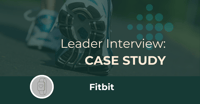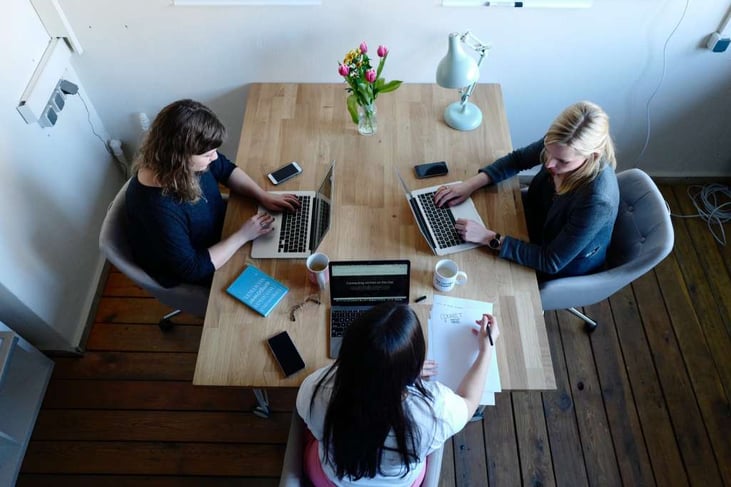Mindful Leadership at Fitbit: Interview with Joyce Bao

SIY Global’s Marketing Director, Carolina Lasso, spoke with Joyce Bao, Senior Product Manager and Product Lead for Sleep and Mental Wellbeing Software Features at Fitbit to learn more about her experience using Search Inside Yourself to enhance her mindful leadership skills.
How did you first find out about Search Inside Yourself (SIY)?
When I first started at Fitbit, I saw in one of the internal newsletters that the program was being offered company-wide. The name and description piqued my interest, as the topics of emotional intelligence and mindfulness were different from other trainings that were being offered. I was really curious as to what the program was about, so I signed up.
Was there anything about the program that surprised you?
This was my first exposure to mindfulness, and I remember that when one of the teachers guided the first meditation I thought, “Wow, that felt really different… in a good way!” Looking back, this program was the seed that started my interest in developing a mindfulness practice. Now, I practice mindfulness on a daily basis and it’s been quite positive and surprising to see that this practice has stuck with me over time.
What were the aspects of the Search Inside Yourself program that resonated the most with you?
The partner exercise of mindful listening. It was the one that resonated the most because it was also the most difficult one for me. Before the program, when I engaged in a conversation, I used to be in my thoughts, you know, having my own dialogue in my head. I wasn’t really there for the other person I was speaking with. The mindful listening practice was quite powerful because it taught me how to listen fully to what the other person was saying and, surprisingly, it also made me feel less anxious. As my own internal dialogue diminished, my anxiety level also decreased. It was such a powerful exercise!
In addition, as I reflect on the program now, I can also say that SIY helped me to develop a sense of connection with other people at work, in a deeper and different way. I kind of always thought that building a deep sense of connection meant that I needed to overshare. Yet, as I reflected on the people I interacted with during the program, I realized that we were able to build a strong connection based on deep awareness, presence, and a sense of respect, all over a very short period of time.
How has your mindfulness practice supported you in your role as Product Lead for Sleep and Mental Wellbeing Software Features at Fitbit?
I always wanted to work in something related to making people’s lives better. I got to lead this part of the business at Fitbit because I’m quite passionate about mindfulness and mental health. I want to be able to help people to get on their happy path. And a lot of that comes from the thoughts that all of us create in our mind.
Prior to Fitbit, I was working in the medical technologies and devices industry. I was in operating rooms very frequently and I noticed that a lot of illnesses that medical professionals were treating were due to people’s poor habits, such as not exercising or not eating well. And I wondered how much that was costing the healthcare system and what could be done to help people improve their health rather than waiting to treat them when they were sick.
And that’s when I decided to work at Fitbit, which focuses on enhancing people’s lifestyles and habits, mainly related to exercise, sleep, and nutrition. Last year I got to work on the sleep features and that was quite interesting because it is the foundation of a healthy lifestyle. Even if you exercise and eat well, but don’t sleep, you can end up having many other problems. During this time I was looking into insomnia and noticed the impact stress can have on that disorder, which made me realize how so many of our issues come down to stress or lack of attention to our mental wellbeing.
If we can help people with their wellbeing, that can have a positive ripple effect on other health problems. So, I am really excited that I am able to work in this field and contribute with different types of tool that can help people better take care of their minds.
These realizations from my own journey have helped me in my own personal life as well. It motivates me every day to see other people really benefit from new ways of living and working.
 Photo by CoWomen on Unsplash
Photo by CoWomen on Unsplash
How has the SIY program supported you as a leader?
As I reflect on what’s my mission in life and what’s next for me, I realize that the answer really comes from knowing myself. Being a great leader requires being a good leader of my own self first.
And it all starts from self-awareness, which is the first part of the SIY program: being crystal clear on my values and what is true for myself. And to get there, a mindfulness practice is key, in order to have a true depth of knowledge about my own life and preferences. Thanks to mindfulness, now it’s easier for me to know my leadership style and how to be the kind of leader I want to be. So the name “Search Inside Yourself” is a great fit because the program is really a doorway to getting in touch with what’s at our core, with depth of awareness. And it’s from there that leadership skills can flourish.
In your opinion, how can emotional intelligence and mindful leadership support a culture of innovation in an organization like Fitbit?
I see what is required for innovation as a pyramid. At the bottom layer you need psychological safety to acknowledge what everyone has to bring to the table. From safety you can move to creativity, which is an alchemy of different people’s strengths coming together and formulating and brainstorming many different ideas (the diverge and converge process). At the top of the pyramid we have a commonly shared goal or a shared vision for the team or project, which should be tied to a higher purpose.
So, to innovate I think you need to start with a safe space to show everyone’s strengths and voices, which can enable creativity, all under a shared higher purpose. And I think that emotional intelligence and mindfulness can really help to enable that kind of space.
In addition to what you’ve shared, are there any other learnings from the program that you’ve been able to integrate at work?
My biggest takeaway from the program in respect to my role is really about learning how to better work with my peers. As a product manager, especially at a fast-paced mid-sized company like Fitbit, I have to interface with over fifty people on a daily basis. Having to adapt to different people’s needs, perspectives, priorities, and interpersonal dynamics requires me to know where my center is.
My ongoing practice allows me to create the opportunity to take a step back and approach these interpersonal dynamics from a place of deep listening and empathy. And this all comes with practice, it’s not something you can just learn or do one day, you have to continue and make it part of your life.
And now I’m wondering what would happen if my whole team were to take the SIY program, how that would make a difference for everybody. I imagine that perhaps it would create a work space that fosters more psychological safety. And what I mean by that is having a space where everyone is acknowledged and their ideas, their voices, and thoughts are heard and respected. And if our teamwork and team cooperation could be based on that, it would create a completely different way of working together.
Overall, I feel as if the Search Inside Yourself program gave me a pack of seeds for my garden. And now I have the choice on which seeds to plant and the opportunity-along with the responsibility-to nurture and tend to my garden so those plants can blossom.
We’d love to hear from you! Connect with us if you’d like to explore ways to bring the Search Inside Yourself program (and more mindful leadership) to your company.
